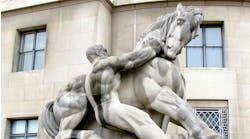BY ROBERT P. MADER
Of CONTRACTOR’s staff
PALM DESERT, CALIF. — Different organizations call empowering employees different things, such as “servant leadership.” Captain Mike Abrashoff, USN-retired, calls it GrassRoots Leadership.
Abrashoff told contractors at the annual convention of the Mechanical Contractors Association of America about his own experience empowering his crew.
It seems like common sense that happy employees would be productive employees — as opposed to brooding, resentful, disenfranchised, and generally ticked off employees.
Abrashoff had the latter. When he took command of the USS Benfold at the age of 36, the ship had unacceptably low morale and high turnover. At the change of command ceremony, the previous captain was humiliated in front of his family when the crew cheered as he left the ship.
“They were actually clapping,” Abrashoff said. “I knew then that command and control leadership was dead.”
One of the first things Abrashoff asked for were the results of the diversity survey. He was told the survey had been taken but not tabulated because nobody wanted to know the answers. When he had the results tabulated, he found out that Blacks and Hispanics said they were being discriminated against, the women said they were being sexually harassed and the white males said that minorities and women received preferential treatment. Noting that the entire crew resentful, Abrashoff ditched the Navy’s diversity program because it was an obvious failure and instituted his own program of mutual respect and treating people the way you want to be treated.
Ditching the Navy’s diversity program was typical of Abrashoff’s command of the Benfold, a guided missile destroyer. Abrashoff used whatever worked and discarded any policies or procedures that didn’t work.
The results over the term of his command were stunning - plummeting workers comp claims, the highest retention rate in the fleet, and the Spokane Award, which is given to the best ship in the Pacific Fleet.
As one sailor told him, the crew was like a bunch of monkeys in a tree. When he looked down, he saw a bunch of smiling faces. When they looked up, they had an entirely different view. Abrashoff realized that he felt the same way about many of the admirals above him.
“The most important thing a captain can do is see the ship through the eyes of his crew,” he said.
Good people always have somewhere else to go, he noted, whether it’s to a different company or a different ship. Many people inside the Navy blamed turnover on low Navy pay. Abrashoff noted, however, that a survey of seamen showed the number one reason was lack of respect and number two was nobody listened to them. Pay was number five.
Abrashoff knew he needed to change the culture on the ship. He’s quick to note that the crew did all the work, he just let them. Abrashoff’s recently published book is entitled “It’s Your Ship,” and that’s the way he ran the Benfold. He empowered the crew, but they had take responsibility for their actions. Among the few limits he set on the crew were you can’t harm anybody, you can’t endanger the ship and you can’t waste the taxpayers’ money.
The crew responded, in many cases brilliantly. One sailor pointed out that all Navy ships were constantly being painted because they used steel bolts and washers on the superstructures. Why not use stainless steel nuts and bolts and nylon washers? The entire Pacific Fleet eventually adopted the practice.
Abrashoff was determined to set an example for his crew and his officers. Once a week, the ship would have a barbeque on deck, and the officers were accustomed to cutting in line, getting their food and eating on an upper deck. At his first barbeque Abrashoff stood in line and talked with the crew. The officers stared at him from the railing of the upper deck and finally sent down a junior officer to ask him why he was waiting in line. Abrashoff told him that he wanted to make sure that his crew was fed before he ate. After that, all of the officers waited in line and ate with the crew.
Perhaps the most important thing Abrashoff did was get to know the entire crew - really get to know them. He interviewed everybody on the ship at the rate of five people per day. He came to see them as individuals and respect his workforce.
Most were poor and joined the Navy for GI Bill benefits. The average age was 24. Only 9% had gone to college. When he discovered how many of the crew had ambitions about going to college, he had an SAT test administrator helicoptered out to the ship. One of the sailors scored a 1490.
Abrashoff was most vexed when the ship failed an engineering certification. The ship failed for a variety of reasons that have to do with ingrained military culture. He discovered, for example, that accidents were sometimes intentional and preceded the ship doing something stupid, but nobody was allowed to speak up. Once again, he ditched the Navy training program for re-certification and created a new program along with his officers and crew.
After training with the new program for eight months, the ship was scheduled for re-certification, usually a six-month process, at sea. He asked to be tested immediately, and the ship passed. His superiors were flustered; no ship had passed the re-certification test that quickly. Abrashoff’s boss wouldn’t let them off the sea duty because it wouldn’t look good to the rest of the fleet. Abrashoff convinced him to shorten it to two months. One of his sailors pointed out that they were already certified and technically didn’t have anything to do for two months, so they should make port calls. They visited Puerto Vallarta and San Francisco.
Abrashoff always made sure he rewarded his crew for their high performance. Every Thursday evening the crew would gather on deck to watch the sunset, listed to jazz and smoke cigars.
The crew suggested Friday night happy hour. While drinking alcohol is forbidden on a ship at sea, that doesn’t preclude Buffalo wings and karaoke, he noted.
The ship’s performance attracted a lot of outside attention. Two managing partners from Price Waterhouse came on board and told him that if it were a private enterprise they would buy the Benfold because they could feel the passion of the people. Fast Company Magazine did a feature on Abrashoff’s management style.
At the end of his command of the Benfold, Abrashoff decided to dispense with the usual speeches-and-brass-band change of command ceremony. He turned to his crew, said, “You know how I feel,” saluted and left. For the next two years, the Benfold remained the top performing ship in the Pacific Fleet.

